- Music
- 26 Jul 24

One year ago today, Ireland lost one of its brightest musical forces of the past 50 years – as news broke of the death of Sinead O’Connor, aged 56. In the days that followed, as tributes poured in from every corner of the music community and beyond, Hot Press editor Niall Stokes shared his own personal reflections on Sinead’s unique artistic, social and political impact. To mark her anniversary, we’re revisiting that special piece today...
Originally published in Hot Press in July 2023:
Sinead O’Connor has died. When something terrible, brutal and heart-breaking of this immediate magnitude happens, the blood might drain from your face, your spirit sink, and your stomach lurch but – in this game – your first instinct has to be professional.
Double-check to make sure it is true. Keep the headline simple. Jesus fucking Christ. It is news that you feared hearing for so long. Now the sledgehammer has shattered the anvil. Hard to focus. But.
But, we are journalists. Or we’re supposed to be. The interweb never sleeps. You can’t not deliver the news, no matter how painful, how sad, how mind-crushingly awful it is. And so you have to blink furiously through the tears that refuse not to come. No matter how well you might know someone, revere them or love their music, there is work to be done. A news story has to be written. Otherwise there is a gaping hole on hotpress.com. Someone has to provide a response. It is important that it strikes the right tone.
All of this is rattling and jangling through your addled brain, like a mess of fuzz and feedback, fizzing through the speakers at the same time.
What can you say in a moment like this?
Advertisement
Knowing what a tough time Sinead had with elements of the media over the years, it seems important to calibrate everything extra carefully.
It is not just about Sinead. You think of her family. Of her father John. Of her brothers Joseph, Eoin and John. Of her sister Eimear. Of her own children, Jake, Roisin and Yeshua.
Of the people who worked closely with her. Who managed her, drummed with her, helped her at every turn in any way they could. You think of how those who have been closest to the fire over many years, and who on occasion got burned, must be feeling right now. The cries of anguish. The tears being shed. The awful tragedy, engulfing a small community of good, kind, decent, loving people.
You know that no words could ever be even remotely adequate to describing the devastation and the grief into which they, individually and collectively, have been plunged.
Mother of fucking Jesus. Life is abominably fucking cruel.
The expletives remind you of Sinead. She could give masterclasses in the effective use of what is sometimes described as foul language. Could have given. And made people laugh so hard, they might forget how savage life really is. Sinead was witty, funny, full of mischief. With a connoisseur’s command of the Dublin vernacular, every glorious profanity ever at the tip of her tongue.
Fuck!
She could be hilarious. You finish a quote. Doubt hovers. It sounds okay for now. You think. There will be opportunities to say more. You hope. The story is hastily hammered into some kind of shape. You give the nod to publish. Nothing feels right.
All of these strands of thought, word and deed are racing simultaneously along parallel tracks, before shooting off to the left and right, to intermingle madly and then separate again. Tracers shooting into the sky and falling, falling, falling...
IT IS A NIGHTMARE
Almost everyone had already left the building, were on their way home, when the word first landed. It is later now, but you don’t know by how much.
The phone is ringing furiously. The story goes goes live. Messages are pinging in. The mobile becoming a menace. Other newspapers, radio stations, TV programmes want a reaction.
Has anyone done the social media? There aren’t many people who could possibly trigger this level of instant, emotional turmoil and the outpouring of grief that is already beginning to gather momentum. But Sinead was truly special. Utterly unique. A brilliant artist. And yet desperately vulnerable. People felt for her. Empathised with her. Wanted everything to be alright for her. It is welling up, this wave of pain. Across the country, you can sense that the tears are flowing. There is shock. Overwhelming sadness. Deep sorrow.
Exhale.
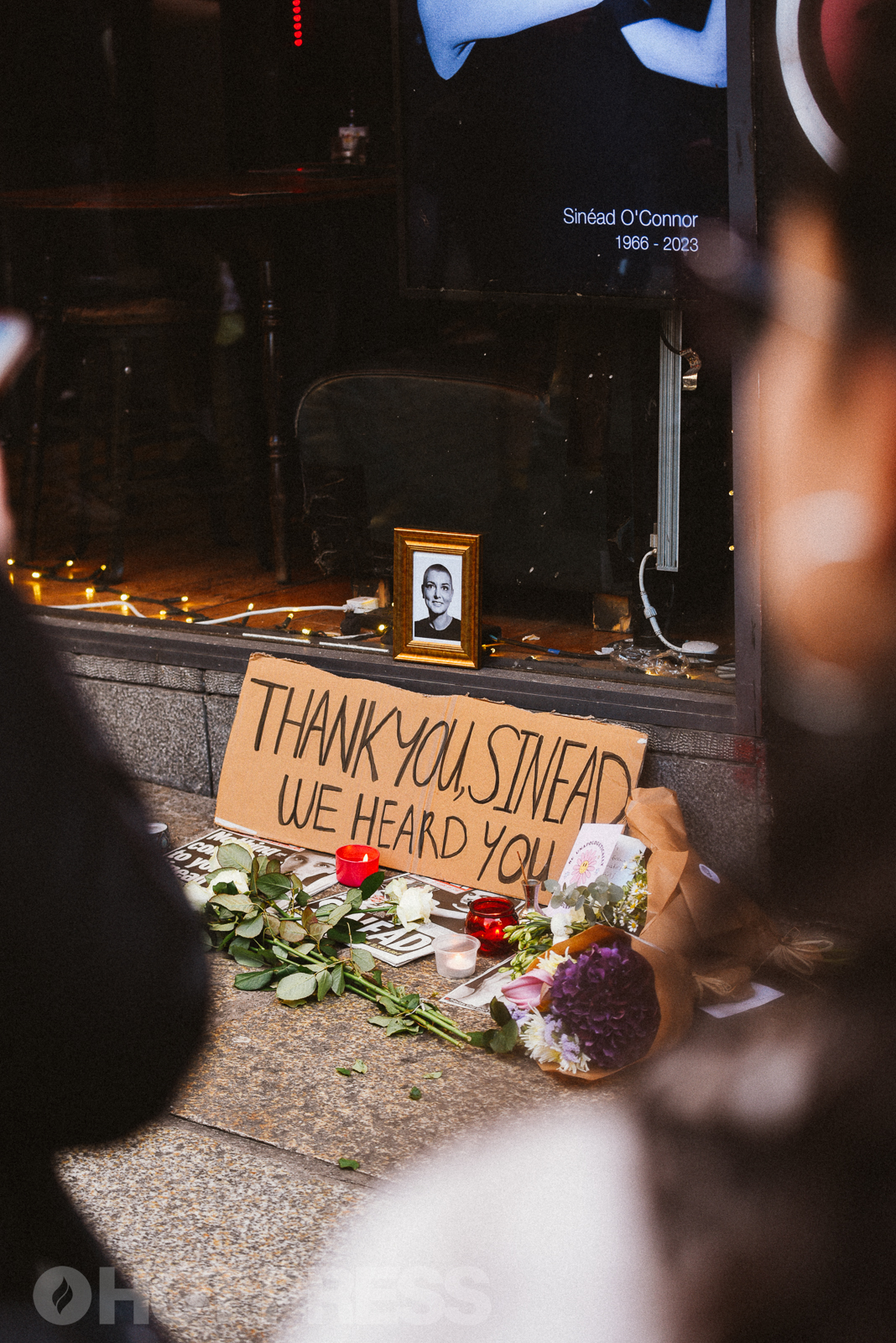
Sinéad O'Connor vigil at Temple Bar, Dublin. Thursday 27th of July 2023. Copyright Miguel Ruiz.
She was a friend. And, in so many ways, a fellow spirit. Someone who grew up reading Hot Press. Who appeared on the cover ten times or more. Whose work you loved. Who called you many times when the shit hit the fan. For whom you’d never have wanted anything but peace, love and understanding.
But, most of all, perhaps, peace.
It may have snuggled up to her in bright moments, but it always dissolved. Sinead lived through bleak and sometimes desolate times when everything was a struggle. Getting up in the morning. Going to bed at night. Trying to hold things together. Trying to survive the internal turmoil. Even trying just to try.
Part of you wants to shut down now. To run away. Or better still to waken up and realise that it was one of those dreams that feel so desperately real that you can’t believe it hasn’t actually happened. You want to will what you have just approved being published online not to be true. But it is. Not a word of a lie.
You remember Christy Dignam. Dolores O’Riordan. The faithful recently departed. You have a sense how much it means to those closest to our fallen heroes to know how greatly they were – how greatly they are – loved. As these thoughts strengthen, it seems like the right thing to do, to step up to the plate. To answer the call. To talk as best you can about the tragic loss of one of our ultimate musical icons. You might be shit, make a hames of it. But you owe it to Sinead, for the music that she gave us, a beautiful gift that kept on giving – that keeps on giving – to at least have a go.
It’s a long day’s journey into night and in the morning it starts again, until you feel all talked out. But the clock keeps ticking. You are awake, and there is no hiding from it...
It was not a dream. It is a nightmare. You go to work.
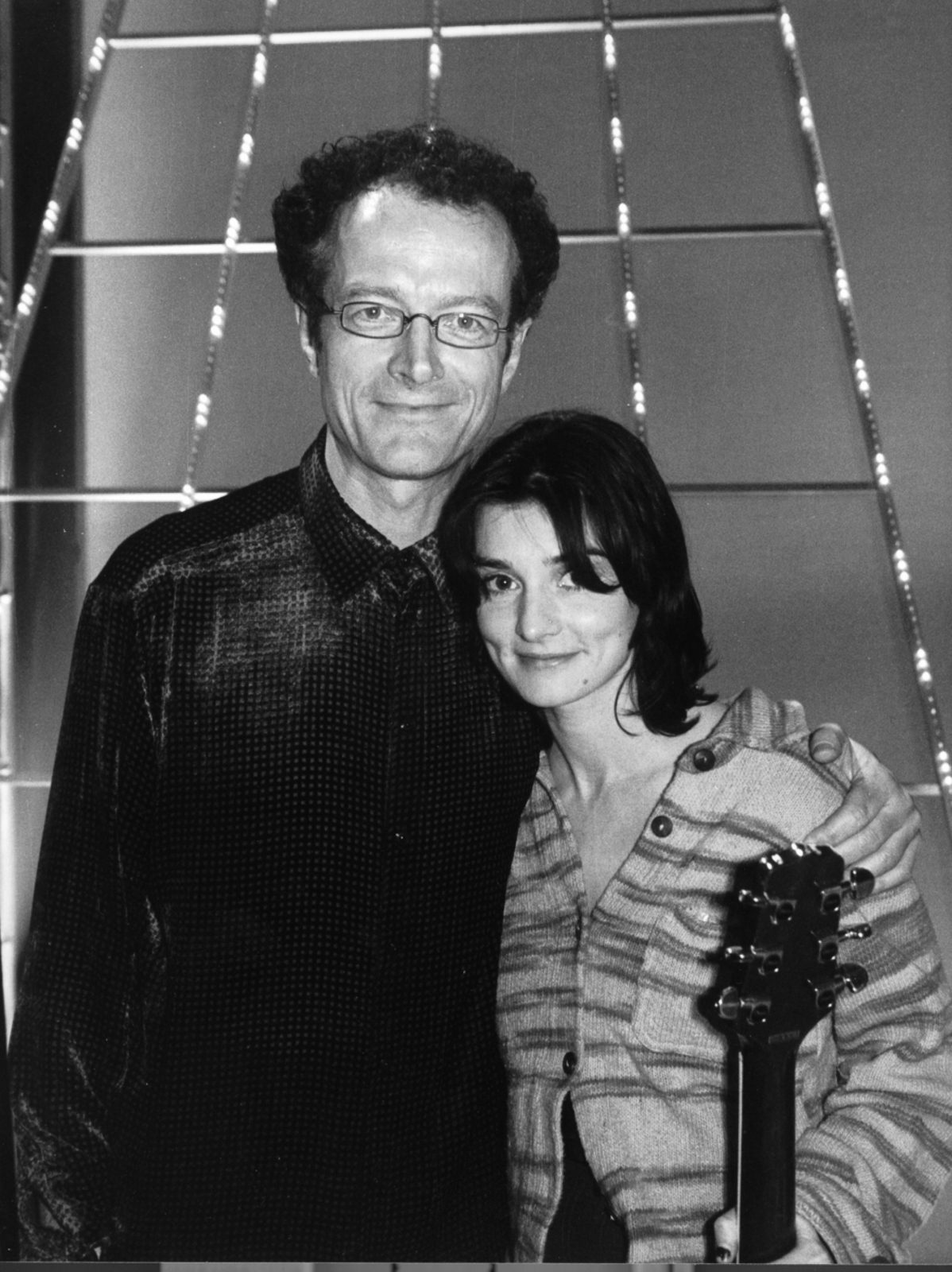
Hot Press Editor Niall Stokes and Sinead O'Connor in 1998.
THE PLANE TOOK OFF
Later. A movie reel. Still pictures and moving images. Soundbites. Almost a lifetime of intel, messages, music and conversations. And more music. Incomparable. Soaring. Cracked. Beautiful.
“There’s this girl singer that rehearsed with In Tua Nua. I’m told she’s, aaaah, bloody marvellous.”
Bill Graham is talking. Hand across his mouth and nose, in that unselfconscious way he had, as if he were smelling the nicotine on his fingers as he spoke. A sidelong look. Ton Ton Macoute. Aaaah. He spits it out amiably. Assumes you know the origin of the name.
The same singer, Bill explains, is now with this new band. The Macoutes, you laugh. Her name is Sinead O’Connor. It would turn out that the singer had connected with the other movers and shakers in Ton Ton Macoute through an ad in Hot Press’ free classifieds. But this conversation is just the mojo-wire in action. Heard it on the grapevine.
Just about to lose my mind.
As you didn’t know till you were told, Ton Ton Macoute had been named after a secret paramilitary police force created in Haiti by the legendary, blood-thirsty US- backed dictator, Papa Doc Duvalier. They, in turn, had been called after a mythological Haitian bogeyman, who punishes unruly children by kidnapping them and putting them in what locals had named “the gunny sack.” We didn’t know it then, but you might have observed that it was prophetic. Sinead had already been there, seen that, nicked the T-Shirt.
1986. The Edge of U2 approached her to sing the main theme for the film Captive, for which he was writing the soundtrack. In a Hot Press cover story, Edge was lavish in his praise of the young singer’s contribution.
A thing of beauty, the track lived up to the promise.
Now the word was out in earnest. Kieran Owens, who was managing The Virgin Prunes, brought her to the attention of Nigel Grainge, the man who had signed Thin Lizzy to the Vertigo label and The Boomtown Rats to Ensign. The train was about to leave the station. Sinead would be on a plane to London soon.
She had been in and out of the Hot Press office in Wicklow Street, and had appeared in a story we did on the new – and thankfully brief – phenomenon of the Kissagram. In what would later be seen as her typical couldn’t-give-a-fuck style, Sinead was doing the gig as a way of earning a few quid. In her first ever official Hot Press photo session, Sinead appeared not as an artist, but dressed up as a French maid.
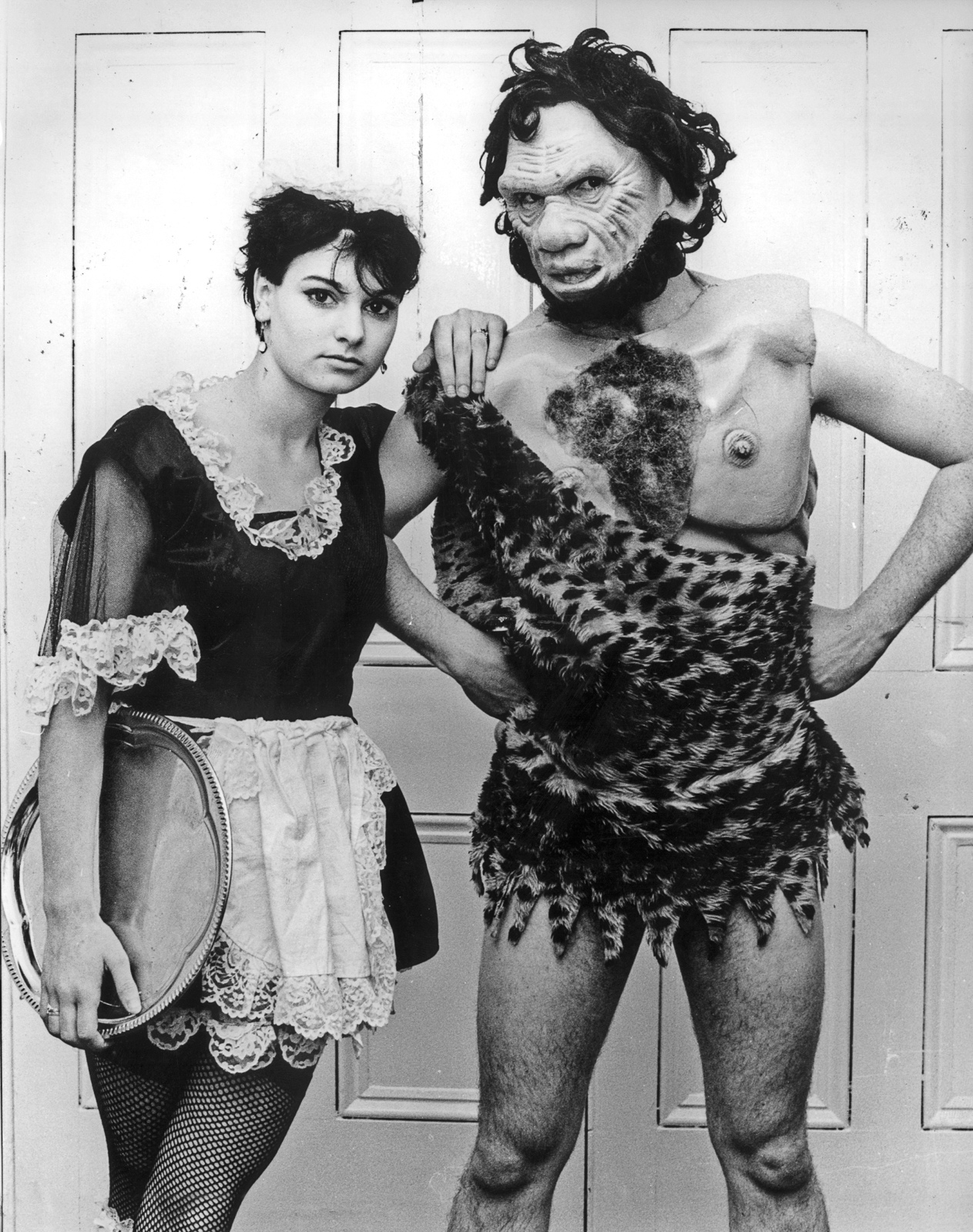
Sinéad O'Connor and Ken Ferrell. Copyright Colm Henry.
I met her properly at a gig, The Waterboys – with former In Tua Nua man Steve Wickham on violin – did in The Olympic Ballroom, in April 1986. During a brilliantly intense performance by a band that was seriously in the ascendant, she was invited onstage for ‘Savage Earth Heart’ and – without a shred of inhibition – traded edgy, soulful, vocals with the ‘Boys mainman Mike Scott. Still only 19 years of age, she didn’t, even for a moment, look out of place on what was one of the biggest stages in Dublin at the time.
Without a shred of inhibition.
I was there with Bill and Mairin Sheehy and we hung around afterwards. Sinead came out to talk to us. Dressed in a white jacket and sporting a black Bob Dylan ‘60s folk-style cap, she was shy and sweet, with gorgeous eyes, a luminous smile and a warm hug. It would become a trademark. She was dressed in the same gear when Colm Henry did a photo session for Hot Press not long afterwards. The following day, everyone was talking about her. How brilliant she had been. Soon afterwards, the plane took off from Dublin Airport. She’d be back on her own fuel.
A PUNK SPIRIT ABROAD
Spooling back now. The 1980s was a brutal time for women in Ireland. The Pope’s visit in 1979 had triggered a triumphalist period of religious dominance, during which the collusion between Church and State intensified. The twisted abortion referendum of 1983 was conceived by the fundamentalists; the politicians bent the knee disgracefully; and the so called ‘pro- life’ 8th Amendment to the Constitution, designed to ban abortion permanently in Ireland in line with Roman Catholic ideology, was passed after a bitter campaign.
It was shocking how many women signed up to the anti-choice bandwagon. The battle for women’s rights – and for control of their own fertility – would go on, but it was hard to see anything changing soon. Religious mania had taken a bizarre hold. People flocked in thousands to see statues of “Our Lady” moving in Co. Cork, a virus of pre- historic superstition that made the front-pages and spread to 30 counties. There were sightings of Jesus on a door in a house in Ballymun.
That decade was also one during which the oppression of women came more shockingly than ever to light. Eileen Flynn, a teacher in Wexford was sacked for becoming pregnant, as a result of a relationship with a married man; Ann Lovett, a fifteen year-old gave birth and died, lying in a grotto in Granard Co. Longford; and Joanne Hayes, also gave birth to and lost a baby in a shed behind the family farm and became the target of the most appalling compound mistreatment and abuse by the Gardaí and the judicial system, in what ultimately became an attempt to frame and defame her on moral terms that had been set by the Catholic Church.
It was a moment when the media in Ireland finally came into its own. There were enough feminists in journalism now to ensure that these stories would not be buried as they would have been in the past. Hot Press was campaigning across all of these fronts. It was time for men to stand in solidarity with women. It was time for women to stand up for themselves.
Sinead, we’d discover, would become a champion for many young women in particular. Breaking a classic showbiz taboo, she insisted on having promo pictures taken while she was pregnant. Nothing to be ashamed about here. She went on to have her first child, Jake, with producer and drummer John Reynolds, in 1987 – the same year that her debut album The Lion and the Cobra was released.
It was a coruscating record, her punky spirit and banshee wail lending the second single ‘Mandinka’ an especially visceral power. “I don’t know no shame,” Sinead sang, “I feel no pain/ I can’t see the flame/ But I do know Mandinka.”
By now, refusing to conform to any stereotype of attractiveness or beauty, she had shaved her head. There was a punk spirit abroad. She was happy to snarl and to howl. And it worked musically. The track was a pop hit, reaching No.6 in Ireland, going Top 40 elsewhere and helping The Lion and The Cobra to No.4 in The Netherlands, No.27 in the UK and No.36 in the US. She had an audience. That, it would soon become clear, was just the prelude.
ARTIST OF THE YEAR
1990. A week into the new year, Chrysalis released the headline single from Sinead’s second album I Do Not Want What I Haven’t Got – her version of a Prince song, ’Nothing Compares 2 U’. The accompanying video was a masterstroke. Shot by John Maybury, it consists almost entirely of a close-up of Sinead’s face. As she navigates the song and delivers the lyrics, the emotional shifts are visible in the young singer’s baleful expression.
And then she hits the opening lines of the final verse.
“All the flowers you planted, Mama,” she sang, “In the back yard / All died when you went away...” Sinead would later say that singing the word ‘Mama’ had reminded her of her own mother – who had died in a car accident early in 1985. That caused a tear to flow down one cheek. The camera didn’t flinch. As the song neared its climax, a second tear flowed, down the other cheek. It was a moment of accidental pop profundity, a marriage of music and video that achieved a riveting impact, on what was, suddenly, the ultimate break-up song.
The video captured the imagination, especially among the emerging generation of young women, catapulting the single to the top of the charts across the world. Sinead O’Connor was the hottest star on the planet. I Do Not Want What I Haven’t Got followed, going to No.1 in almost 20 countries and selling over 2 million copies in the US alone.
In addition to ‘Nothing Compares 2 U’, the album contains emotionally devastating songs like 'The Last Day of Our Acquaintance’, ‘Black Boys On Mopeds’ – a protest song about the killing of the 21 year-old black British citizen Colin Roach by the Metropolitan Police in London, and the subsequent cover-up – and 'Three Babies’. The first word was that this was about three miscarriages Sinead had suffered, but she debunked that theory when she recounted that it was about an abortion she had undergone. Sinead would not be cowed.
With her emotional rawness, pugnacious image, open attitude to sex and sexuality, magnificent command of curses, beguiling sense of mischief, and wide grin when she was having fun, she cut an inspirational figure. All over Ireland – as so many women have been at pains to tell me this past week – teenage girls and young women started to feel more confident in themselves and assertive of their independence.
At the end of 1990, we named her Artist of the Year. She did a Madonna and Child-style photoshoot for Hot Press, beautifully handled by Colm Henry that we put on the cover of the Christmas issue. We should have left the red wrapping paper off, but I remember that everything went to the wire and decisions were made late into the next morning. In the interview, for the first time ever, she spoke to Helena Mulkerns about the night she had to run away from Prince’s house. She trusted us not to sensationalise. And so we talked more regularly.
FEMALE MUSICAL ICONS
Deadlines. They are like manacles. You can only move this way or that by so much. Far too many memories crowding in to capture here, with the clock ticking. Every old staffer I talk to now mentions that they remember Sinead calling for me early and often. She didn’t bother with flunkies or minders. She went straight to the editor. The dogsbody. The driver.
She’d call to talk. Sometimes she needed comfort.
She found fame hard. Didn’t want to play the game, but enjoyed the opportunities it offered to say what she needed to say. She wanted to fight the real enemy. Her instinct was pure. On 3 October 1992, she tore up a picture of the Pope after launching into a cover of Bob Marley’s ‘War’ on Saturday Night Live, because she had seen, read, heard and experienced enough to believe that the Roman Catholic Church had been engaged in the systemic abuse of children and covered it up. In Ireland. And all over the world. And that they were still at it in a monstrously hypocritical, dishonest way.
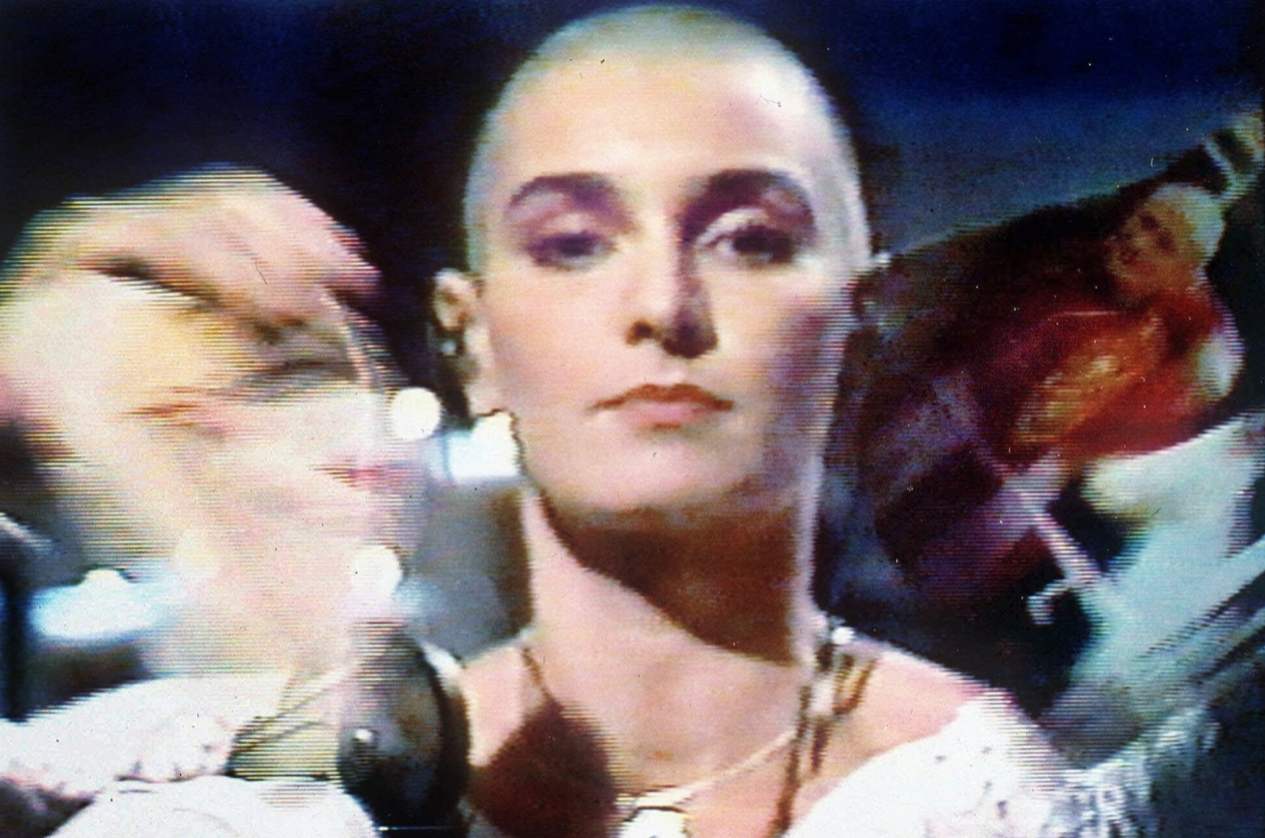
Sinéad O'Connor on Saturday Night Live – October, 1992
I had forgotten that I travelled to London, to interview Sinead in Chrysalis Records, when her follow-up album Am I Not Your Girl? was released that same year. She was feeling battered and bruised. Half the audience had turned on her at the Bob Dylan tribute concert a fortnight after the SNL appearance. The hatred in the air was visceral, animal, frightening. Some of the musicians kept a distance. She told me how Kris Kristofferson had seemed like an angel, offering a shoulder to lean on. She performed ‘War’ again anyway and left the stage as voices for and against clashed in an unholy babel, poisoning the Madison Square Garden air.
Too many memories. Listening to the beautiful ‘You Made Me The Thief Of Your Heart’, recorded for Jim Sheridan's brilliant movie In The Name of the Father, with Sinead, Gavin Friday and Bono in STS Studios in Dublin. Visiting The Shell Cottage in Kildare with her and Ian Galvin to meet Marianne Faithful.
She phoned the house a lot in those days. My son Rowan, who was 7 or 8 at the time, liked to answer when the bakelite started shrieking. Sinead would chat to him sweetly. About the ninth or tenth time, she asked him ‘Do you like jokes?’
Yes. ‘Well, did you hear the one about polar bears?’
Or rather about a polar bear with identity issues. He remembers it still.
“The little bear came home after his first day at school,” she began, “and he said to his parents: ‘Am I a polar bear?’ They reassured him: ‘Of course you’re a polar bear’. And he nodded: ‘OK’. They thought that’d be the end of it, but no. The same thing when he came home on the second day. ‘Am I REALLY a Polar bear?’ Again the same answer: ‘Don’t be silly – of course you’re a polar bear’. And he nodded and went off to eat his herring supper. And on the third day he arrived home looking particularly anxious. ‘Are you absolutely SURE I’m a polar bear?’ he demanded, stamping his foot. They looked at one another and then down at him. ‘We told you yesterday and the day before that you’re a polar bear. Why do you keep asking such a silly question?’ There was a pause. And then he bellowed in the loudest voice he could muster: “Then why am I fucking freezing!”
Strange scenes with Sinead and B. P. Fallon outside the Sin É Café in New York with Allen Ginsberg performing inside and a cop looking for trouble. Finding Sinéad’s scarf in the back of the car. Meeting her, this time looking desperately pale and drawn, for another Hot Press interview. A special cover shoot with Shane MacGowan and Christy Moore for a Hot Press birthday issue. I could go on.
And then there was Nina Simone.
We decided to invite the great North Carolina folk, gospel, soul and blues singer to Dublin, to pick up a Lifetime Achievement Award at the Hot Press Awards in 1999. I remember the conversations with Mike Edgar of the BBC, who were broadcasting the awards, about who’d be best to make the presentation. Sinead would be ideal. I volunteered to ring her. She said yes immediately. “I absolutely love Nina Simone,” she enthused. Looking back now, I couldn’t have imagined anything more wonderful than being onstage alongside those two extraordinary, inspirational, enviably original female musical icons, as Sinead – dressed to the nines in her newly acquired priestly garb – handed over the beautiful piece of Waterford Crystal we’d had designed by the renowned Irish designer John Rocha. The applause was deafening.
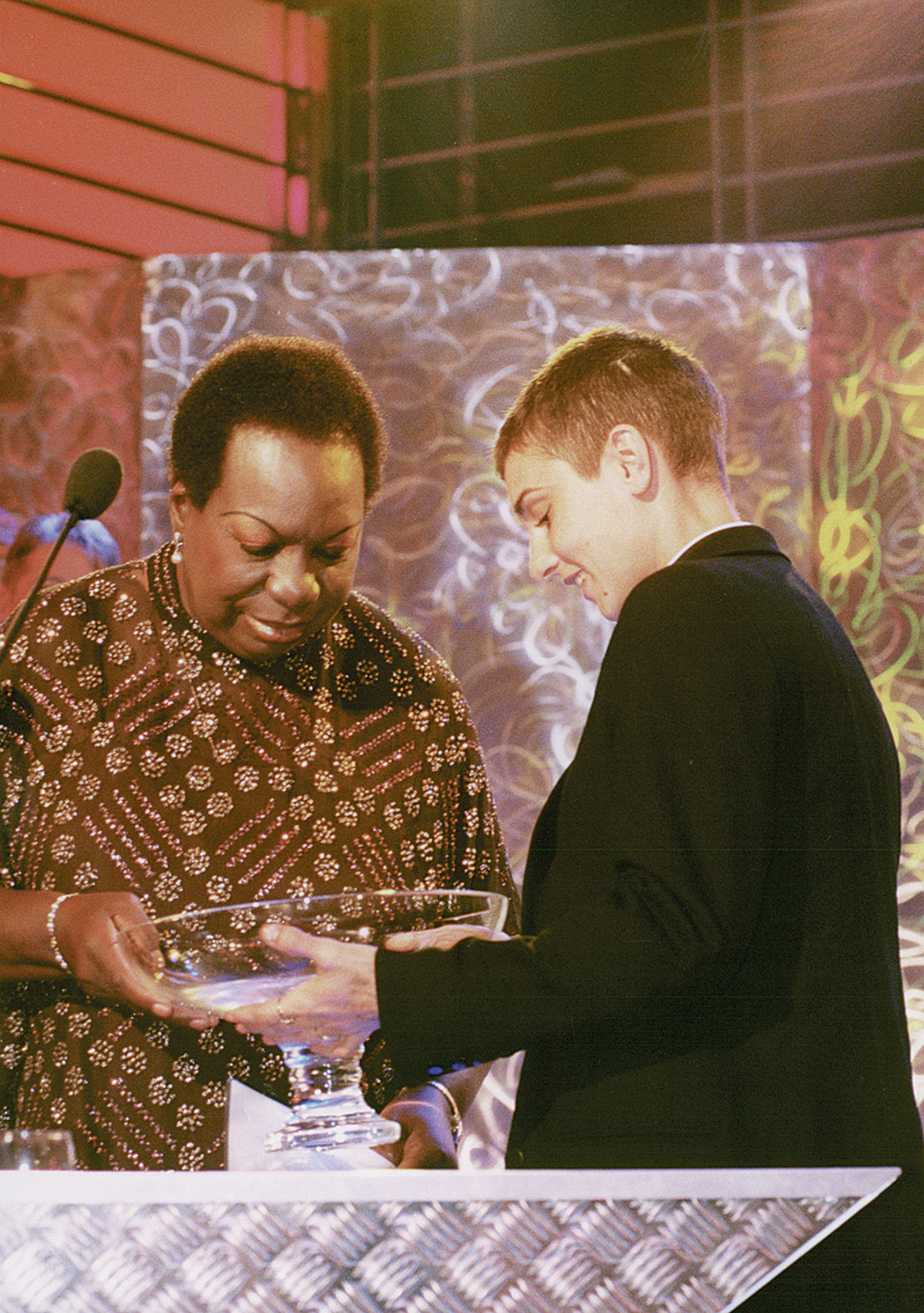
Sinéad O'Connor presents Dr Nina Simone with a special award for her lifetime achievements in music at the 1999 Heineken Hot Press Awards in Dublin. Copyright Colm Henry.
THE FINAL GRIEVING HAS BEGUN HAS BEGUN
Having been launched into the spotlight at a young age, Sinead struggled with many aspects of being what people call a star.
She made no secret of the fact that she was battling with mental health issues. She lived with anxiety all her life. She was diagnosed as bipolar. And later with PTSD, and other ailments. Sometimes she wasn’t able to cope. Other times she came back fighting strongly.
Everyone who loved her worked hard, in different ways, to assist as best they could. For those closest to Sinead – her immediate and extended family in particular – it was a long and desperately hard road. They gave her love and support. But there were times when the illness talked. Hearts were broken. Souls too. None of it was intended. I know from my own experience of serious mental health conditions within my own family, which required psychiatric intervention, that with individuals who are in a running, long-term battle with demons hell-bent on colonising the mind, no matter how hard a family tried or tries, the solution is never available to them.
Sinead travelled that dark road. And yet she continued to produce great music to her own timelines. Marvellous songs like 'Thank You For Hearing Me’, 'No Man’s Woman’ and ‘4th and Vine’, from How About I Be Me (and You Be You)?, with John Reynolds beside her in the lovely video, made by Kathryn Ferguson and released in 2012. Brilliant interpretations of Irish classics like ‘She Moved Through The Fair’ (changed to ‘He’ for the Michael Collins movie directed by Neil Jordan), ‘My Lagan Love’, ‘The Parting Glass’, ‘Danny Boy’ and 'The Foggy Dew’ (with The Chieftains). The divine duet with Willie Nelson on ‘Don’t Give Up’. Her powerful, declamatory version of Blind Willie Johnson’s ‘Trouble Will Be Over’. And singing the beautiful ‘Who Knows Where The Time Goes?’ with Lumiere. Just for starters.
There were the lyrics. The image. The provocations. The polemics. And then there was that voice. A pure magical thing that will linger forever in the dreams and imaginings of those who heard her. She knew how to deploy a mic better than anyone else I ever saw up close. She used it as an instrument. She dragged it away as she hit the high notes and pushed the voice harder. She drew it in when she whispered. She made it look as if it was part of her, a bionic extension of the arm. And all the while, what you were hearing was marvellously singular. Inspiring. The Sinead-ness of Sinead.
We remained friends always. One of the last interviews she did was with Stuart Clark for Hot Press and it was another great one, Sinead giving it loads on Black culture, civil rights, the abuse of power, the importance of standing up for what was – what is – good and right. And when we met later, the hugs we exchanged were as warm and generous as they had always been.
She was one of a kind. Troubled. Vulnerable. But unmistakably always who she was. One of the greatest Irish artists of the past 50 years. Yes. One of the most important and influential singers in the world. Yes. Ground-breaking. Trail-blazing. Warm. Tender. Fiery. Fierce. A lover. A fighter. A poet. With a voice to change the world.
The best-known Irish woman of all. Someone we knew just by her first name. Sinead. All over the planet people are grieving for her. Her family are bereft. But her genius and her memory will live on.
“Oh, trouble, soon be over, sorrow will have an end,” she sang on that Blind Willie classic. “Trouble soon be over, oh, sorrow will have an end.”
There would be some consolation in believing that it might be so. But for those who loved her, the final grieving has just begun.
Following Sinead O'Connor's death in July 2023, Hot Press released a one-off tribute edition, dedicated to the legendary Irish artist – featuring heartfelt contributions from Bob Geldof, The Edge, Hozier, Denise Chaila, BP Fallon, Moya Brennan, John Reynolds and more.
For readers who missed out, there’s a small number of copies still available of this beautiful limited edition publication – which has resonated with fans right around the world










